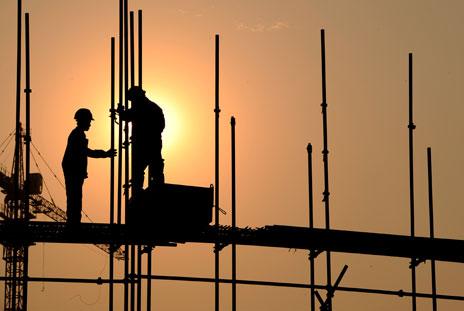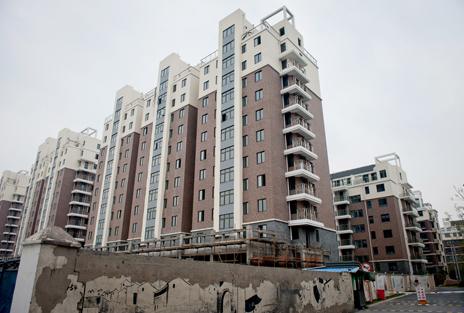The good and bad of China's growth
- Published
- comments

So the good news is that China's economy is growing at a marginally reduced annual rate of 7.7% per annum.
And the bad news is that China's economy is growing at a marginally reduced annual rate of 7.7% per annum.
What do I mean?
Well, whether or not you regard China's official economic statistics as beacons of empirical accuracy (few do), it is clear that there's no hard landing in China, no precipitate end of the high-growth era, whose implications (some bad, some good) would be felt the world over.
But there is an argument, which I have spent the last few months investigating in a film for BBC2 (which is finished, and will be broadcast soon-ish), that the current main sources of Chinese growth are unsustainable - and that the longer growth remains at this kind of rate, the more spectacular and damaging the eventual reckoning will be.
How so?
Well, the first thing to say is that it's all our fault (I am not being wholly flippant).
Because the big flaws in China's economy worsened in 2008, in the immediate aftermath of a banking crisis which was a Western phenomenon but which hobbled growth and demand almost everywhere.
In particular it undermined China's export-led economic model. When Europe and the US in effect went bust, we no longer wanted to buy all that lovely cheap stuff made in China, so China's economy ground to a halt, prompting the urgent need for another way.
A very courageous Chinese government might have taken the opportunity to engage in the kind of "demand rotation" that it and the world really needed - namely to put through big reforms which would have encouraged its 1.3 billion people to consume and spend much more.
This would have involved rapid liberalisation of its financial sector, to provide better returns on investment, and a fundamental loosening of the supply of consumer credit. And there would have been substantial steps towards the establishment of a proper welfare state, which would have obviated the need for the Chinese to save six times what we save (as a share of disposable income).
If there had been a significant rise in the share of the Chinese economy represented by consumption, from a third to nearer the two-thirds of mature decadent economies such as ours and that of the US, China's long term growth prospects would have been enhanced - and the stagnation of our economies would not have been so elongated, because there would have been much better opportunities for our own exporters.
However, it wasn't to be.

China's government took the view that re-engineering on that scale brought excessive risks, in that there undoubtedly would have been a marked deceleration of growth for some time, during the period of structural change, and the risks to political stability would have been too great.
The fear of the Chinese government was that unemployment would have risen to levels in which discontent with economic stewardship might have transmuted into open criticism of the one-party state. The bargain between Communist Party and people - prosperity as the dividend for sacrificing democratic rights - would have been broken.
So instead the government went for an apparently more direct and easy resuscitation - it created the mother of all investment and lending sprees.
To be clear, in 2007 most economists were even then arguing that China was too dependent on investment, with expenditure on plant, equipment, buildings and infrastructure already 40% of national income, or GDP.
But rather than there being a "rebalancing" away from investment, it actually shot up, to 50% of GDP. There was a splurge on remaking the urban and industrial landscape, more or less unprecedented in history.
Wherever you go in China, you can see the fruits, from the world's tallest skyscrapers and longest bridges, to roads that seem to go nowhere and mind-boggling numbers of unoccupied new homes.
What's more, those legacies of the Maoist era, the state-owned enterprises, had a new lease of life - on Beijing's orders - creating huge new productive capacity.
That yielded the short term benefit of expanding employment, and the long term cost of killing their profitability, because so much of the new capacity was beyond what the market could bear.
All of which was a bit short-termist, especially for a government famed for its 10-year plans. But the biggest danger stemmed from how all this investment and expansion was financed.

A newly built housing project in Hangzhou, eastern China
The government ordered the banks to "open their wallets". And my goodness how the banks obliged.
And after Beijing became anxious that the growth in direct bank lending was perhaps more rapid than was consistent with the maintenance of proper credit standards, the banks showed the kind of creativity that would have made a bonus-bulging City or Wall Street investment banker proud. There was an explosion of lending through "shadow banks", which were nominally separate from the banking system, but much of the liability was still effectively with the banks.
The consequence was that lending has been rising at an unsustainably fast annual rate of 15% of national income per annum since 2008, so that total debts are now twice GDP, and the total liabilities of the banking system exploded by $15tn over that period.
Or as Charlene Chu, late of ratings agency Fitch puts it, just the increment in the balance sheets of Chinese banks since the 2008 crash is equivalent to the aggregate size of US commercial banks, whose balance sheets have grown to that point over a century.
Chu does not think an economy can be weaned off that degree of addiction to debt-fuelled growth without - ahem - there being some kind of shock to the economy.
But even if you thought she was being unduly pessimistic, you would want the rate of lending and investment to grow at least no faster than the economy - because the longer they grow faster than the economy, the greater the danger that eventually the debt burden and the write-offs of lousy investments become unaffordably big.
Or to put it another way, the longer that China has the wrong kind of rapid growth, the greater the risk that an eventual crash will muller China and bring contagion to connected financial institutions and economies.
That brings us back to those good and bad GDP figures published today.
They show that fixed-asset investment (excluding rural households) increased by 19.6% last year, down slightly from 20.6% in the previous year. But - and this matters - investment was up much more than retail sales (13.6% higher) and industrial production (9.7% up).
Or to put it another way, China remains hooked on debt-fuelled investment. There is no healthy rebalancing.
Now, the government has announced a 10-year plan, at its recent plenum, to gradually increase the share of consumption in growth, and tilt away from construction and investment.
Will they succeed? How long will it take? And what are the consequences for China and us if they don't?
Well, in the words of the original Batman and Robin TV series of the 1960s, tune into my BBC2 documentary (in just a few weeks) to find out (sorry for the shameless plug - and see my colleague Linda Yueh's note for more on all this).